HTC Sensation 4G Review - A Sensational Smartphone
by Brian Klug on July 1, 2011 12:38 AM EST- Posted in
- Smartphones
- HTC
- Android
- Mobile
- HTC Sensation
- MSM8260
Performance
I’ve been skirting around it for no real reason, but the obvious other big important feature on the Sensation is that it’s the first dual core 45nm snapdragon SoC we’ve looked at in a shipping device. The HTC Sensation is built around a 1.2 GHz Qualcomm MSM8260 SoC with Adreno 220 graphics and integrated Previously, we looked at 3D performance on a 1.5 GHz Qualcomm MSM8660 in a Mobile Development Platform, and briefly in our initial hands on preview piece at Uplinq. There, we saw that performance was about where it should be given the difference in resolution between what we had tested (WVGA - 800x480) and the Sensation’s qHD (960x540) display.
The elephant in the room is what CPU performance on MSM8x60 is like. Dual core snapdragon consists of two scorpion cores clocked at up to 1.5 GHz. Anand is going to give a much deeper CPU architecture dive when he looks at the MSM8660 inside the EVO 3D (again, the x in MSM8x60 merely denotes which modem is onboard), but for now I’m going to present all the benchmark results for the Sensation.
First up are our web benchmarks, which primarily test JavaScript and page rendering. We’re still running SunSpider 0.9, though we’ll soon switch to 0.9.1 and report that alongside. JavaScript performance on HTC’s browser isn’t as good as it should be, and I’m a bit disappointed here that things aren’t better. We’ve seen HTC’s browser result in lower scores before, but it still is at odds with what Qualcomm has told me about how closely the two collaborate to optimize V8 for scorpion.
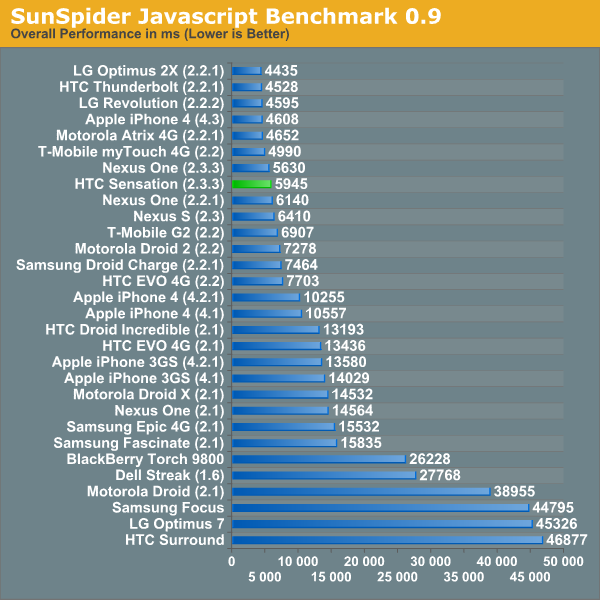
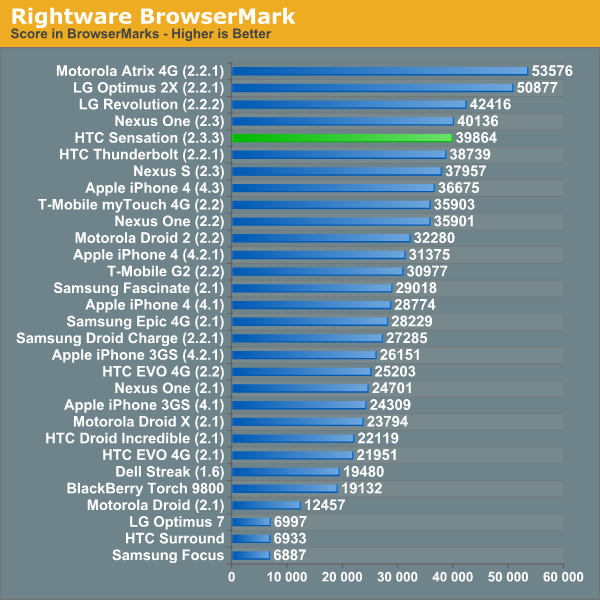
Flash is next, and here the Sensation delivers pretty good performance. It’s hard to make a direct comparison against the Optimus 2X again because we’re dealing with WVGA versus qHD, and we run this test aspect scaled.
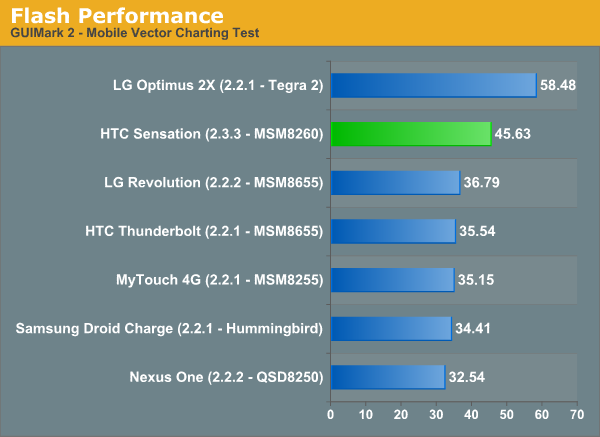
I’m putting Neocore up next because I want to mention again that we’re capped at vsync. We had some hope for a while that we could turn vsync off on handsets, however this is only possible on development hardware, not final ROMs that ship in devices. Odds are you won’t see this pop up again in our suite unless we can make it actually say something. We’re at the Surround’s 60fps wall even at qHD.
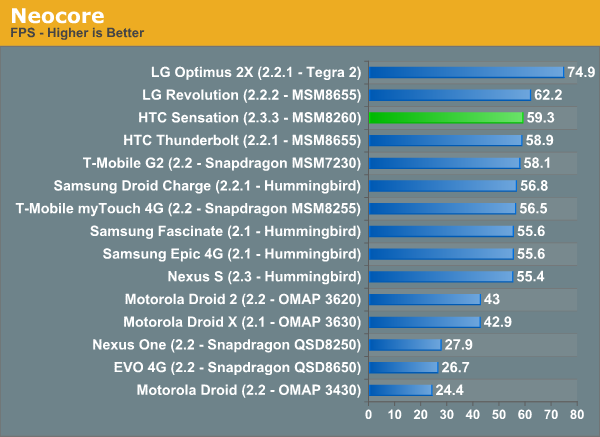
GLBenchmark 2.0 is a mainstay in our benchmarking section, and I’ve already broken down results in our HTC Sensation hands on back at Uplinq. Things have actually improved a bit since that hurried benchmark run over dinner in San Diego, with the Sensation posting around 2fps higher in Egypt and Pro. Again keep in mind the resolution differences between everything here, there’s a 1.35x increase in pixels going from WVGA to qHD.
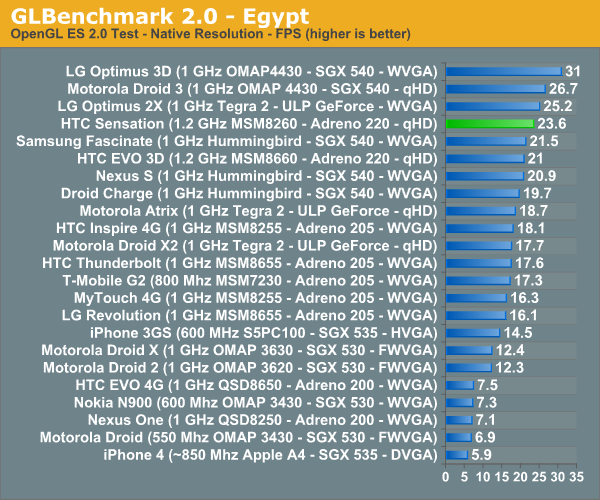
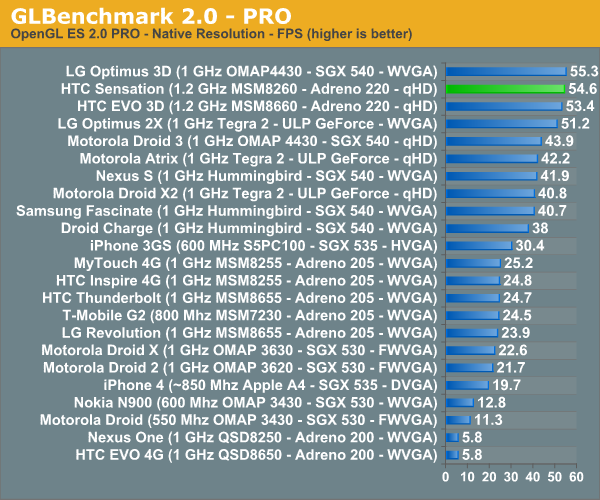
Next is BaseMark ES2.0, which is a nominally updated version of the hugely popular, industry-standard 3DMarkMobile ES2.0. Here we run at the default resolution, which is VGA, and thus get a picture without being constrained to just native resolution constantly. This one is a bit new for us, and I expect that Anand and I are going to explain things a bit more in the EVO 3D story. For now, just take away that MSM8x60 appears very speedy.
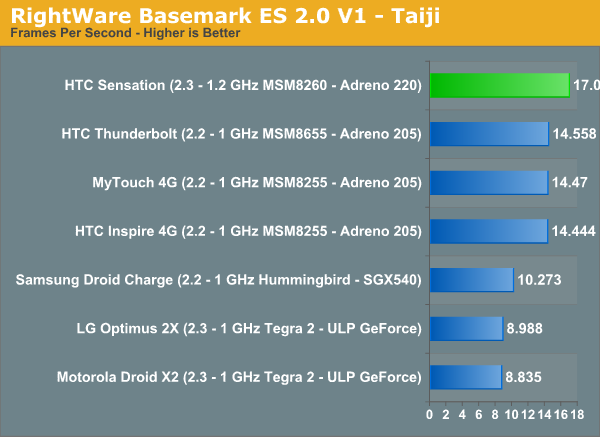
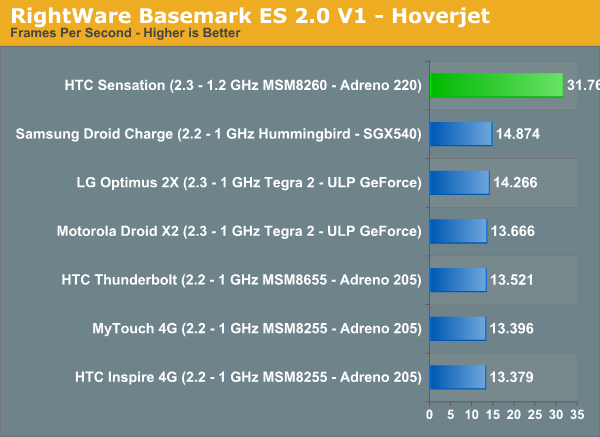
The Android port of Quake 3 is what we sort of started all of this mobile 3D benchmarking with, and we’re still running it even if it’s starting to hit vsync. The results look strange here until you realize that this is again running at native qHD resolution on the Sensation.
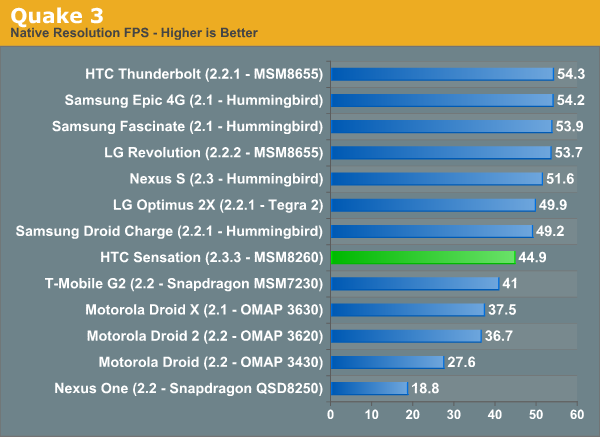
Next up is Linpack, which added a multi-threaded benchmark mode earlier this week. I’ve run it on all the dual core devices I could get my hands on. The initial multi-threaded version had some issues which were fixed on Tuesday, giving more accurate results. We’ll still run the single-threaded version alongside. The 20% jump in clocks shows itself nicely on the Sensation in single-threaded linpack compared to all those 1 GHz MSM8x55 phones we’ve tested.
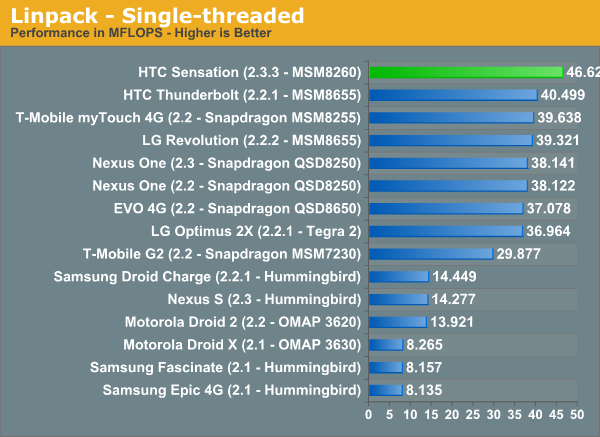
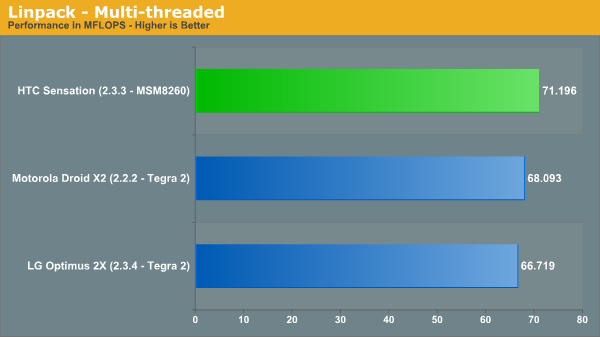
Last and most definitely least is Quadrant, which I think we've gone over our numerous reasons for disliking a few times. The tests themselves are starting to look seriously dated, including 3D tests which render improperly on Android 2.3 and are themselves up against the 60fps vsync cap through their respective runs. I'm sure that the rest of the poorly documented subtests are equally as subpar, however it's become something of a de-facto standard in certain circles.
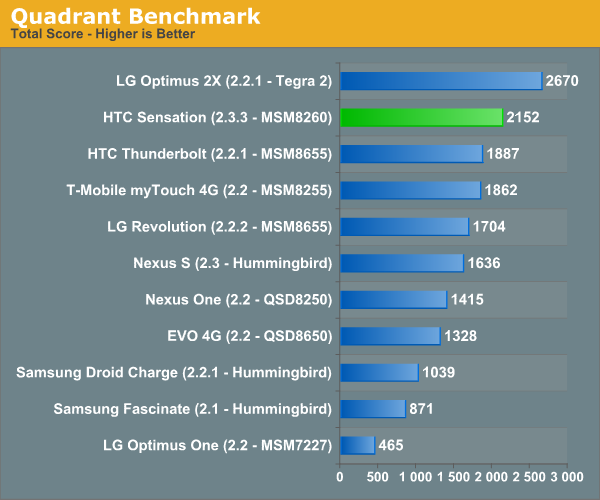
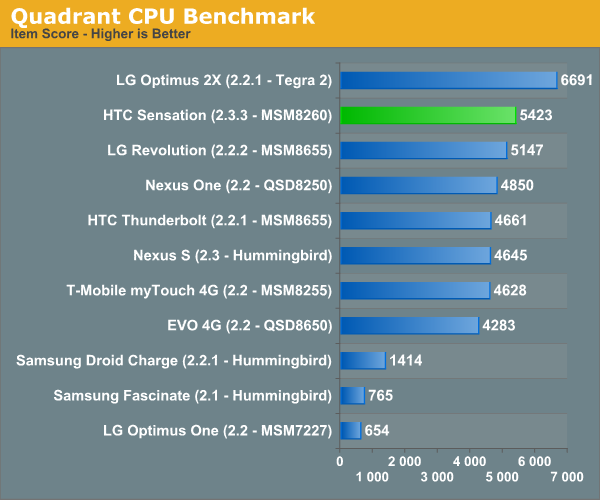
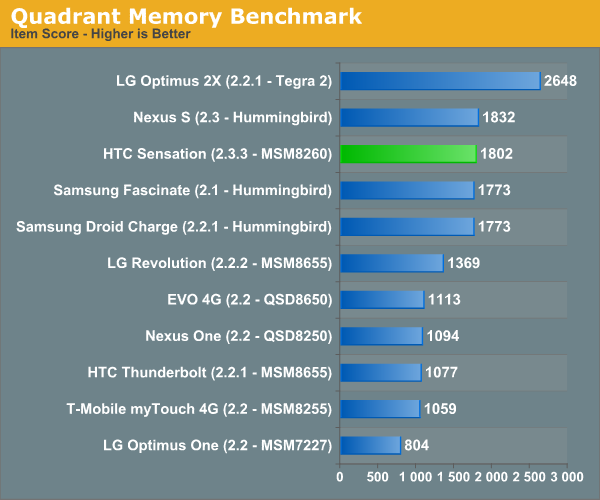
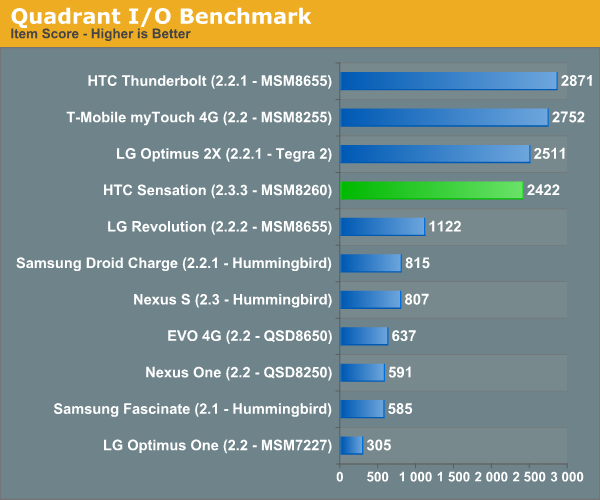
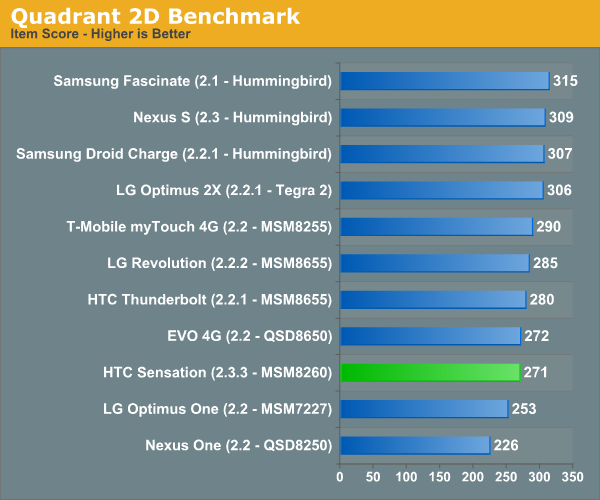
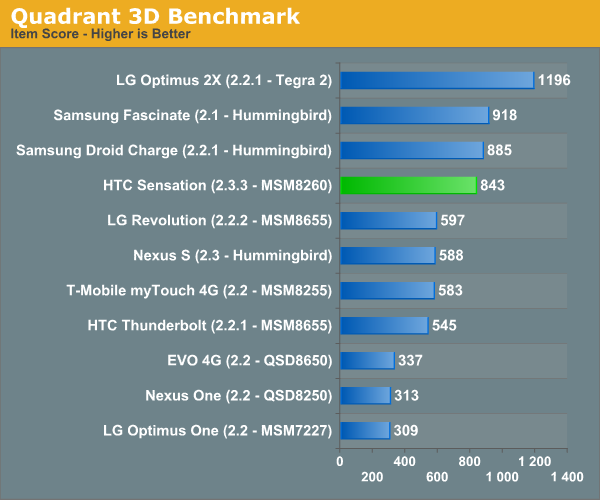
As an aside, I don't think we'll see Quadrant around for much longer, as there are better, more robust, fully documented tools by some established big names coming to the Android market (for free) shortly. All of those will probably quickly and thankfully replace Quadrant, as they all are gunning for its "go-to standard" status as the tool everyone runs, at least from the Android market. I have no doubt they'll quickly succeed.
The state of benchmarking on Android right now is a bit unbalanced, and what everyone wants is a system trace or general use benchmark that will show more than how the CPU does in synthetics and the GPU in synthetics. I fully expect all of that to change this calendar year. Just be patient.










107 Comments
View All Comments
iwod - Friday, July 1, 2011 - link
It looks like in Browser Benchmark, iPhone 4 with iOS 5.0 will properly rise to the top. And it is great to see after a year of its introduction, iPhone 4 is still playing very well with it competitors.About Screen Size, Brian would you and Anand makes notes which size of screen you prefer.
For iPhone 3.5", I think a lot of us want a bigger screen. But what size? 4", 4.3" or even larger?
Brian Klug - Friday, July 1, 2011 - link
I think 4.3" is really the upper limit for smartphone displays. I've got the Infuse 4G here beside me, which is 4.5", and that already is almost challenging to hold sometimes, and occasionally awkward to type on. Factor in the fact that it has just a WVGA display, and those pixels are positively gigantic.Personally, I prefer 4 or 4.3". Anything above that is starting to just get excessive. I can only imagine what that rumored 4.7" HTC WP7 device is going to look like.
-Brian
Chaser - Friday, July 1, 2011 - link
After an iPhone 3G, Droid, Evo, Galaxy S and G2x this phone finally gets it right in so many ways, It never ceases to impress me.Sense 3.0 with Gingerbread makes it perfect!
dtomilson - Friday, July 1, 2011 - link
Being a tech blog I have always found Anandtech to publish articles on the same phone is the same phone is the same phone (Android). Any updates coming on the beta of Mango that has been released? How smooth it is and how much better it performs given the lower specced hardware the current-gen devices use..karnovaran - Friday, July 1, 2011 - link
Brian, there has been much debate on XDA about screen quality differences resulting from the Sensation panels being manufactured by two different companies: Sharp and AUO (Acer). I'd love to know which panel you were reviewing.Can you tell us which panel you have? The way to check is by downloading terminal emulator from the market and running the following command: dmesg That will spit out a bunch of information, just hit menu and email it to yourself then search for "panel". Thanks.
Brian Klug - Friday, July 1, 2011 - link
I always run dmesg on devices just so I can see a bunch of different things/hardware ;)Just grepped out panel and found the type:
<6>[ 1.603759] mipi_novatek_panel_type_detect: panel_type=PANEL_ID_PYD_SHARP
-Brian
quiksilvr - Friday, July 1, 2011 - link
Ahh T-Mobile. It's almost tragic. They have awesome phones but...what's the point? Once the merger happens you have to change the phones and there isn't a full guarantee that our prices will remain the same for monthly bills.Conficio - Friday, July 1, 2011 - link
So apparently the T-Mobile phone does not yet have the boot lock removed and knowbody knows if that will be some software update.Hence question what are then the "unlocked" HTC sensation phones that float around in on EBay etc.?
I ask, because I'm about to get an HTC Sensation (buying it outright) but I want to be able to operate the phone with other carriers SIMs (internationally). So is the T-Mobile phone locked to their network?
Conficio - Friday, July 1, 2011 - link
How much of the htcsense.com features work over Wifi. Does remote Wipe or location tracking work?In other words, does the location get determined by the phone and sent back to htcsense.org or is it determined by the carrier?
Brian Klug - Friday, July 1, 2011 - link
I don't know about location, but I'm assuming that if it uses the Android location framework, it will work. Remote wipe and lock does indeed work over just WiFi, in addition to just cellular.-Brian